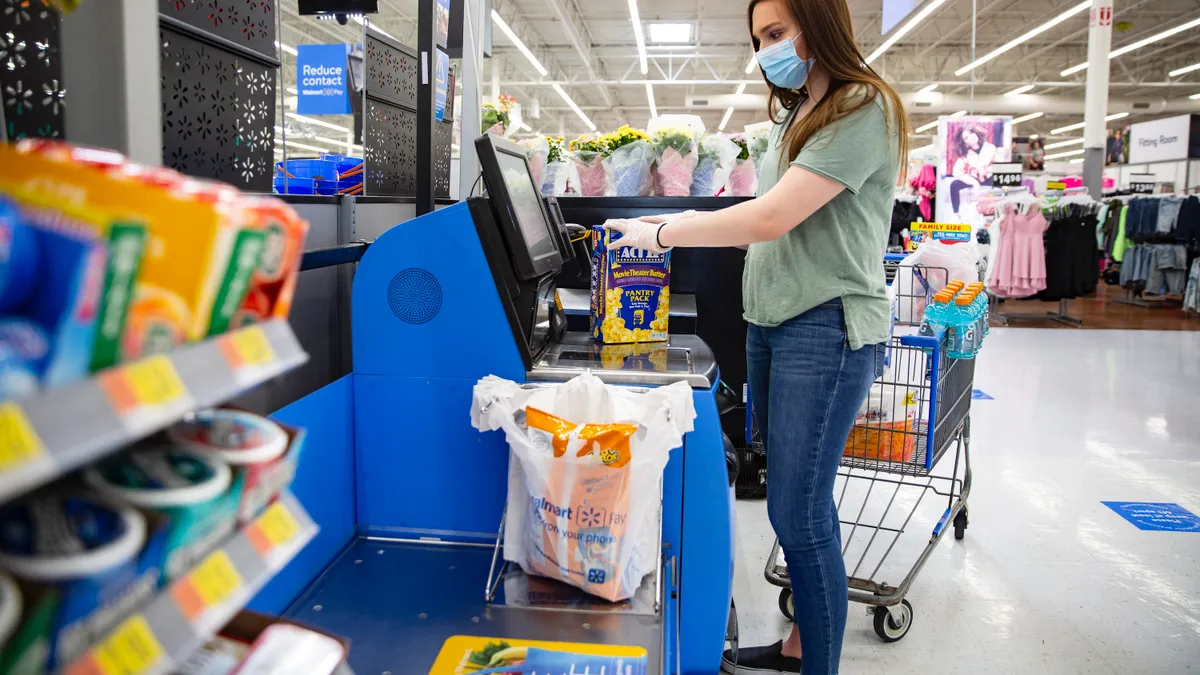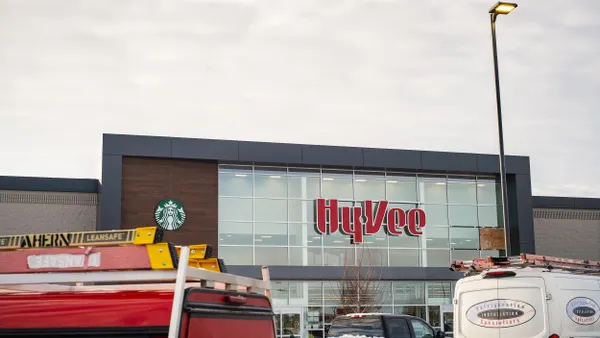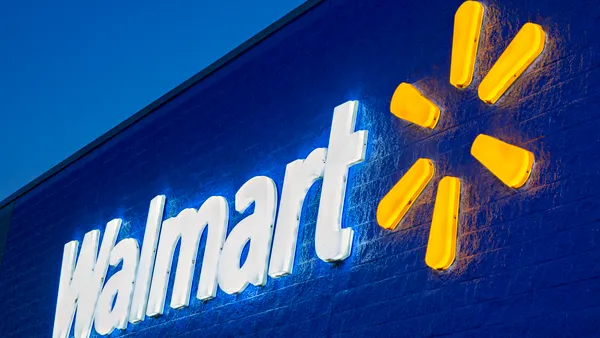From drone and autonomous vehicle deliveries to adding automated micro-fulfillment to dozens of stores, Walmart has a reputation for embracing digital innovation.
In the past few months alone, the company has announced it's testing a text-to-shop tool and further consolidating its app with universal search and checkout, while Sam's Club is developing a new version of its Scan & Go technology and piloting a new app feature called Scan & Ship that lets shoppers select in-store items to get shipped to them.
Walmart is leveraging technology and scale as competitive advantages, especially as it competes with e-tailer Amazon. In an interview with Keybanc at the financial firm's Technology Leadership Forum last week, Suresh Kumar, Walmart's global chief technology officer and chief development officer, provided a look at how the retailer approaches digital innovation as it hones in on its omnichannel strategy.
Here are the top five takeaways from what Kumar shared.
Deciding to build or partner
Walmart has several high-profile technology partnerships, including Adobe and Ford. It has also gone through several breakups with partners, nixing pickup towers made by Estonia-based Cleveron and distributed by Bell & Howell, and ending the use of Bossa Nova Robotics’ shelf-scanning robots for inventory management.
“Given our scale, we want to build and we want to focus our tech on areas that are core to our business, where ownership actually gives us the ability to be able to adapt the software to our business needs,” Kumar said, based on a Refinitiv transcript.
But when in-house software is too expensive to roll out in some areas or markets, Kumar said Walmart will turn to commercial software that can scale to its needs.
“It's not just about building our technology, and it's not just about taking the technology, modularizing it, servicing it and making it available for others, but it's also about creating the overall ecosystem so everything kind of builds on itself and everybody ends up benefiting from that,” he said.
Walmart is also turning technology into a revenue stream, Kumar noted. Its Adobe partnership, for example, enables Walmart to offer its cloud-based pickup, delivery and fulfillment services to retailers. This summer, Walmart also started selling its white-label delivery platform to other businesses.
Offering cashierless tech
While some retailers, like Amazon, are diving into cashierless stores, Walmart is relying on offering a range of checkout options.
Cashierless tech has played a major role as Walmart looks to reduce friction and make checkout as easy as possible, Kumar said. Mobile scan and go, which is available at Sam's Club and for Walmart+ members, has so far solved a big customer pain point around waiting in long lines, he said.
Walmart has tested cashierless technology in stores, including replacing cashiers with self-serve checkouts at several stores in Canada, creating an "experimental checkout experience" at a Supercenter in Fayetteville, Arkansas, and opening a cashierless Neighborhood Market store in Florida.
But Kumar noted that not all customers want to use some or all of the technology options, so cashiers are needed.
"We will continue to have all of these things," Kumar said about combining cashierless tech with cashiers.
Exploring disruptive technology of the future
As Walmart uses technology to be a leader in retail disruption, Kumar pointed to several areas the company is exploring that it sees as the most disruptive technology in the coming years.
Kumar said voice technology is a "very natural extension" of reducing customer friction. Already, the company has made voice tech available to its workers: The Me@Walmart app offers a voice-activated personal assistant, called Ask Sam, that was previously available as a standalone app to some associates.
"I think over a period of time, the most natural way in which you are going to interact with a system that's out there, including for shopping, is going to be through voice," Kumar said.
Kumar said he's also excited about doubling down on blockchain, which Walmart primarily uses for food transparency, particularly with leafy greens. "If there are industry recalls, you can very, very quickly identify if Walmart received product from the impacted source," he said.
Walmart is considering blockchain in multiple areas "as a mechanism to be able to automate the transactions between suppliers, carriers, logistics," he said, noting that traceability and transparency with blockchain could potentially tie into regeneration and sustainability efforts.
Virtual try-ons, which Walmart already offers for clothes, could also apply to home and outdoor goods with the use of augmented and virtual reality, Kumar said.
"You can take the furniture and you can place it in your living room. Let's say, you're trying to buy a tent ... You don't want to actually buy it and try to set it up and then find out that it's not working for you," he said.
As technologies continue evolve, their promise ultimately comes down to making shopping easier.
"I look at it primarily from, is it reducing customer friction? Is it making it easier for them to shop? And on the back end, is it allowing us to drive insights better and faster and be able to reason our data more effectively?" he said.
Leveraging machine learning and AI
Walmart has turned to machine learning and artificial intelligence to help save money, create personalized experiences at scale and make workers more efficient, Kumar said.
For example, Walmart has a predictive basket that uses machine learning and AI to understand shoppers’ history, preferences and what they typically buy to create an add-on experience.
The company is also building out its ability to do omnichannel assortment planning to figure out which stores need which products out of the millions it offers, and how to phase those in. “What ML and AI allows you to do is to bring all of that information together and to be able to synthesize it and to be able to gain insights into that,” leading to more dynamic management, Kumar said.
Walmart has also employed the technologies to make store associates' jobs easier. Its Me@Walmart app, which debuted in June and was built in-house, uses machine learning, augmented reality, camera vision and AI, letting U.S. associates clock in on their mobile device, view their upcoming shifts and request schedule changes, among other features. Kumar said Walmart is currently working on a tool for corporate workers that is “very similar” to Me@Walmart.
Machine learning and AI are also helping Walmart save money: Its use of machine learning for markdowns save the company more than $30 million, Kumar said. Earlier this year, Walmart said it saw shopper acceptance nearly double for substitutions — a tricky part for online orders that can lead to sales loss and dissatisfaction — since it started using deep learning AI, which imitates how brains process data and can learn without human supervision, for online grocery orders.
Placing more focus on safety
Walmart's customers have stayed focused on value and convenience during the pandemic, but have increasingly cared about safety, Kumar said.
Kumar highlighted several ways Walmart has used technology to address safety concerns. For example, the retailer added curbside pickup for pharmacy items last December and rolled out mobile scan and go — a feature available to Walmart+ members — to all locations.
Last spring, Walmart made changes to its pickup and delivery services and to Walmart Pay, which lets people link a payment method in the app and then scan a QR code at a register, to make shopping more touch-free.
Going forward, Walmart will continue to rely on not just input from its customers who shop online or in-store, but also observations of what other companies are doing, trends and what's talked about on social media to help determine its next digital innovations, Kumar said.












